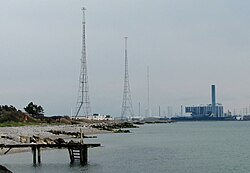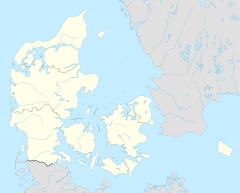
Medium wave (MW) is the part of the medium frequency (MF) radio band used mainly for AM radio broadcasting. The spectrum provides about 120 channels with more limited sound quality than FM stations on the FM broadcast band. During the daytime, reception is usually limited to more local stations, though this is dependent on the signal conditions and quality of radio receiver used. Improved signal propagation at night allows the reception of much longer distance signals. This can cause increased interference because on most channels multiple transmitters operate simultaneously worldwide. In addition, amplitude modulation (AM) is often more prone to interference by various electronic devices, especially power supplies and computers. Strong transmitters cover larger areas than on the FM broadcast band but require more energy and longer antennas. Digital modes are possible but have not reached momentum yet.

In radio, longwave, long wave or long-wave, and commonly abbreviated LW, refers to parts of the radio spectrum with wavelengths longer than what was originally called the medium-wave broadcasting band. The term is historic, dating from the early 20th century, when the radio spectrum was considered to consist of longwave (LW), medium-wave (MW), and short-wave (SW) radio bands. Most modern radio systems and devices use wavelengths which would then have been considered 'ultra-short'.
RTÉ Radio 1 is an Irish national radio station owned and operated by RTÉ and is the direct descendant of Dublin radio station 2RN, which began broadcasting on a regular basis on 1 January 1926.

The Hellissandur longwave radio mast is a 412 m (1,352 ft) tall guyed radio mast used for longwave radio transmissions of RÚV. It is situated at Gufuskálar, near Hellissandur on the Snæfellsnes peninsula of West Iceland. It is currently the tallest longwave radio mast in the world and the tallest above ground structure in Western Europe.

The Roumoules transmitter is the main broadcasting facility for longwave and mediumwave broadcasting of Radio Monte Carlo near Roumoules, France and is owned by Monaco Media Diffusion. The 1000 and 2000kW transmitters installed are among the most powerful in the world and can be received well at nighttime throughout Europe.

The Langenberg transmission tower is a broadcasting station for ananlog FM Radio and Digital-TV signals. It is located in Langenberg, Velbert, Germany and owned and operated by Westdeutscher Rundfunk, WDR.
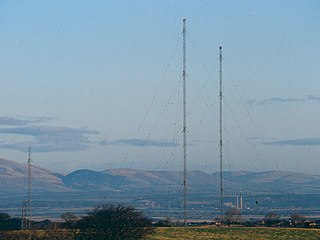
The Westerglen transmitting station is a facility for longwave and mediumwave broadcasting established in 1932 at Westerglen Farm, 2 miles (3 km) south west of Falkirk, Stirlingshire, Scotland.

The Clarkstown radio transmitter was a longwave radio transmitter in County Meath, Ireland. The mast was located approximately 3.5 kilometres (2.2 mi) east of the village of Summerhill, in a field south of the R156 regional road at Clarkstown. At 248 metres high, it was more than double the height of the Spire in Dublin.

The Transmitter Ismaning was a large radio transmitting station near Ismaning, Bavaria, Germany. It was inaugurated in 1932. From 1932 to 1934 this transmitter used a T-antenna as transmitting antenna, which was spun between two 115-metre-high free-standing wooden lattice towers, which were 240 metres apart. As this antenna had an unfavourable vertical radiation pattern, which produced much skywave resulting in a too small fading-free reception area at night, in 1934 a new antenna was installed. Therefore, one of the towers was dismantled and rebuilt on a 39-metre-high (128 ft) wooden lattice base. While this work took place, an L-Antenna was used, which was spun between the other tower and a small auxiliary wooden tower. It became defunct in 1977 and was destroyed in 1983.

Grimeton Radio Station in southern Sweden, close to Varberg in Halland, is an early longwave transatlantic wireless telegraphy station built in 1922–1924, that has been preserved as a historical site. From the 1920s through the 1940s it was used to transmit telegram traffic by Morse code to North America and other countries, and during World War II was Sweden's only telecommunication link with the rest of the world. It is the only remaining example of an early pre-electronic radio transmitter technology called an Alexanderson alternator. It was added to the UNESCO World Heritage List in 2004, with the statement: "Grimeton Radio Station, Varberg is an outstanding monument representing the process of development of communication technology in the period following the First World War." The radio station is also an anchor site for the European Route of Industrial Heritage. The transmitter is still in operational condition, and each year on a day called Alexanderson Day is started up and transmits brief Morse code test transmissions, which can be received all over Europe.
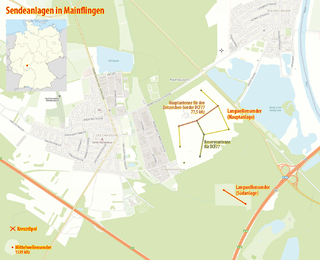
The Mainflingen mediumwave transmitter is a mediumwave transmission facility south of the A3 motorway near Mainflingen, Hesse, Germany. Mainflingen was the first mediumwave transmitter for the radio station Deutschlandfunk. It went into service in 1962 with a transmission power of 50 kW, on a frequency of 1538 kHz, at the upper end of the mediumwave band. This frequency has a bad groundwave propagation and therefore a low range at daytime, but an excellent skywave propagation with a long range at night.
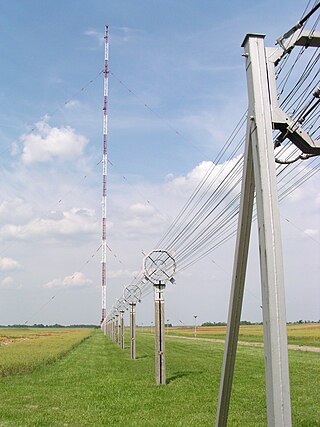
The Transmitter Solt is a radio transmission facility for 540 kHz MW near Solt, Hungary, serving as the primary transmitter site for Kossuth Rádió. With an output power of 2000 kW, it is the most powerful radio transmitter in Europe and is among the most powerful radio transmitters in the world. Its intended broadcast area covers the Hungarian-speaking territories of Central- and Eastern Europe, however successful reception of the Kossuth Rádió was reported from as far as Michigan, United States and Kuala Lumpur, Malaysia. It uses a 303.6-metre tall guyed mast. The transmitter site has been a preserved industrial monument since 2013.
The mediumwave transmitter Flevoland was a broadcasting facility for medium wave near Zeewolde in the province of Flevoland, Netherlands, situated at 5°25′ E and 52°23′ N. It has been used for broadcasting on 747 kHz and 1008 kHz with a nominal power of 400 kilowatts. As aerial two guyed steel framework masts with a height of 195 metres are used, which form an anti-fading aerial. These masts are grounded and carry a cage aerial, which is upperward the separation insulator, separating the masts in a height of 95 metres in two parts, connected toward the mast construction. The radiation diagram is directional, with a maximum gain of 4 dB in South-Eastern direction, to compensate for the variation in electrical admittance of terrain in the Netherlands.
A broadcast transmitter is an electronic device which radiates radio waves modulated with information content intended to be received by the general public. Examples are a radio broadcasting transmitter which transmits audio (sound) to broadcast radio receivers (radios) owned by the public, or a television transmitter, which transmits moving images (video) to television receivers (televisions). The term often includes the antenna which radiates the radio waves, and the building and facilities associated with the transmitter. A broadcasting station consists of a broadcast transmitter along with the production studio which originates the broadcasts. Broadcast transmitters must be licensed by governments, and are restricted to specific frequencies and power levels. Each transmitter is assigned a unique identifier consisting of a string of letters and numbers called a callsign, which must be used in all broadcasts.

The Beidweiler longwave transmitter is a high-power broadcasting transmission site owned by RTL Group and operated by RTL company Broadcasting Center Europe. It was used to transmit the French-speaking programme of RTL on longwave frequency 234kHz until 1 January 2023. Based in Beidweiler, Luxembourg, the transmission site is situated at 49°43'58" N and 6°19'08" E and went into service in 1972 as replacement of the old Junglinster Longwave Transmitter. Junglinster remained in use as a backup site and for additional broadcast services.
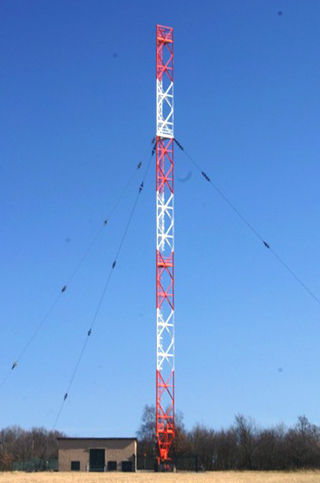
Marnach transmitter was a broadcasting facility of RTL near Marnach in the commune of Clervaux, in northern Luxembourg. The Marnach transmitter was built in 1955 for improving the transmission of the English-speaking program on 1439 kHz, which was transmitted from 1951 with an omnidirectional antenna from Junglinster, to the British Isles and for a better transmission on this frequency to Germany at daytime. Therefore, it was given a directional antenna with a switchable directional characteristic pointing North-northeast towards the Rhine-Ruhr area, Germany's most populated area, and West-northwest in the direction of the UK. This antenna was implemented in form of a directional antenna consisting of three ground-fed 105-metre (350') tall guyed mast antennas arranged in the form of an isosceles triangle with a 90 degree angle. As transmitters, two 100 kW units switched in parallel were used when it went in service in December 1955.

Dillberg transmitter is a transmitting facility of the Bavarian Broadcasting Company on the 595-metre-high Dillberg mountain west of Neumarkt in der Oberpfalz, Bavaria, Germany. Dillberg transmitter went into service in 1955 for serving the area of Nuremberg with TV and FM radio programmes from a 198-metre-tall guyed mast.

Weiskirchen transmitter, is a mediumwave broadcasting tower in Weiskirchen, Germany. It is the property of Hessischer Rundfunk. It was built in 1967

Nador transmitter is the main transmission facility for longwave and shortwave of Medi 1 Radio, a privately owned broadcasting company of Morocco. It is situated approximately 18 kilometres south of the city of Nador and a few kilometres south of Selouane at 35°2'29"N and 2°55'7"W.
DR Radio was a division of Danish Broadcasting Corporation - DR - concerned with radio programming. The radio stations are now part of several divisions: DR Medier (P1), DR Ung (P3), DR Musik, DR Danmark.
